Table of Contents
Looking to enhance your body’s stability while effectively strengthening your entire physique? Consider incorporating exercises with an exercise ball, engaging the deep stabilizing system of the spine, commonly referred to as the CORE. In addition to working your abdominal muscles, these exercises also contribute to the strengthening of your arms, back, and hamstrings. This promises a functional full-body workout, offering a dynamic addition to your training routine, whether at home or in the gym.
How to Exercise With an Exercise Ball?
The exercise ball, also known as a gymnastic, balance, or stability ball, is a popular fitness accessory with versatile applications. Many people use it simply for sitting, which is really a missed opportunity. It can be effectively used to exercise the entire body, and due to its efficient engagement of the deep stabilizing system of the spine, you can simultaneously improve your coordination and balance. This improvement can benefit you not only in everyday life, but also in sports activities. Enhanced body coordination and stability can be advantageous in activities like running, weight training, or team sports such as football. Lastly, the exercise ball is also commonly used as a rehabilitation aid. [1–3]
In addition to the exercise ball, you’ll also need a mat and enough space around you to work out. From the provided exercises, you can create a standalone workout (HIIT, circuit training) or choose some to add to your existing training routine. To achieve results, it’s important to perform these exercises regularly, ideally 2–3 times a week. Gradually increase their difficulty, or add more repetitions or sets. Lastly, make sure to rest, as it is crucial for recovery, and support your results with a balanced and nutritious diet.
Do some HIIT:
- pick 4-6 exercises
- perform each exercise for 30 seconds, followed by a 30-second rest
- then move on to the next exercise, and after completing all of them, you’ll have finished one set
- take a 1-2 minute break between each set
- perform 3-4 full sets
Try circuit training:
- pick 4-6 exercises
- gradually perform 8–20 repetitions of each exercise
- for isometric exercises like the plank, aim to hold the position for at least 15 seconds
- perform 3-4 full sets
- take a 1-2 minute break between each set
If you primarily exercise at home and want to achieve the best results, you can’t do without a training program. The article “How to Create a Proper Training Program for Home Workouts?” can help you with that.
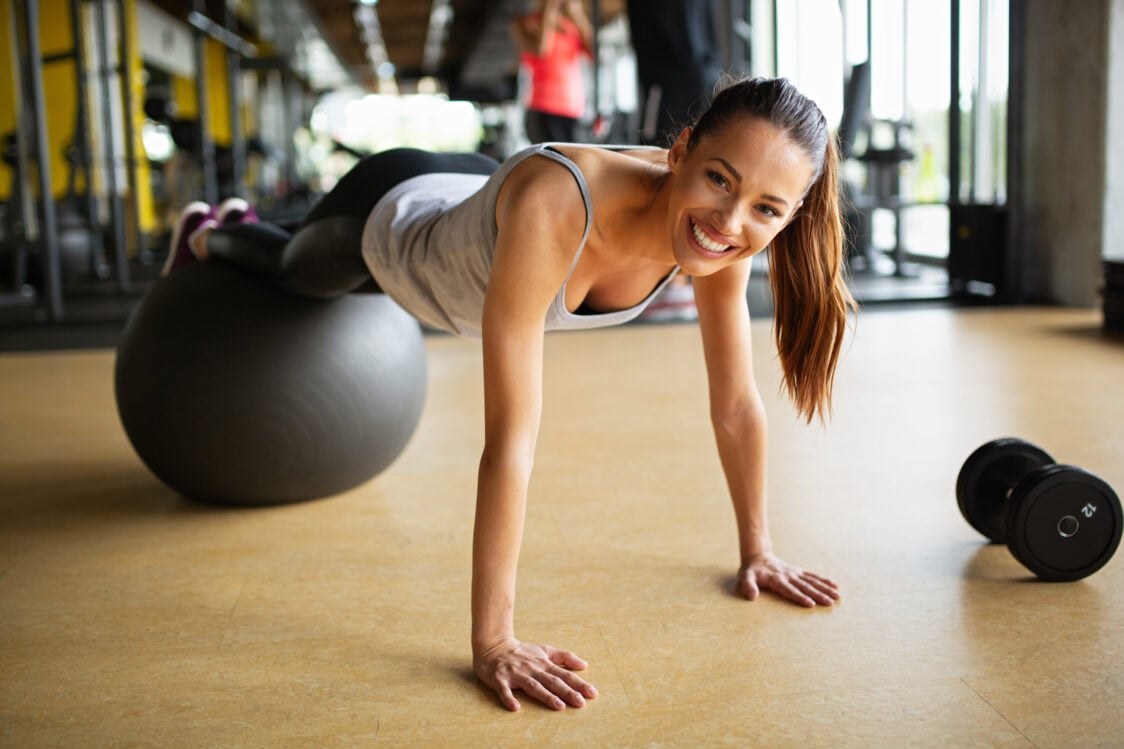
8 Effective Exercises With an Exercise Ball to Improve Stability and Strengthen Your Whole Body
Among the exercises listed below, you’ll find movements to target your abs, core, back, as well as hamstrings. Feel free to try the basic version or explore simpler or more challenging variations. Emphasize slow and controlled movements, as these exercises require stability and coordination. Prior to diving into the main workout, make sure to warm up lightly—perhaps with some jogging in place or skipping rope. Loosen up your entire body by rotating the major joints. And, after completing the main session, dedicate a few minutes to stretching for a well-rounded routine.
1. Plank Leg Lifts
- Starting Position: Assume a plank position with extended arms, placing your shins and knees on the exercise ball. Position your hands to be approximately under your shoulders. Extend your legs, tighten your body, and try to keep it in a straight line.
- Execution: Keep your body stabilized and, while exhaling, lift one of your extended legs. It’s sufficient to raise it just a few centimetres above the exercise ball. Then, inhaling, lower it back down, and repeat the exercise with the other leg.
- Common Mistakes: Arching your back, uncontrolled movement, excessively lifting your pelvis upwards.
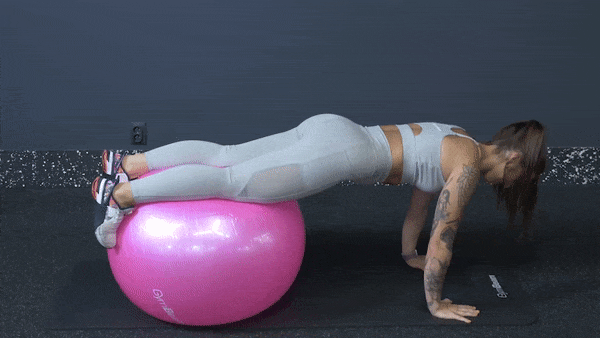
Easier or harder variation of the exercise
You can simplify the exercise by moving your hands closer to the ball. Conversely, a more challenging variation involves moving the ball farther from your palms or holding the lifted leg up for several seconds.
You might be interested in these products:
2. Pike
- Starting Position: Assume a plank position with extended arms, placing your shins and knees on the exercise ball. Position your hands to be approximately under your shoulders. Extend your legs, tighten your body, and try to keep it in a straight line.
- Execution: Activate your abdominal muscles to lift your hips upward, aiming to align your hips with your shoulders. Gradually increase the range of motion. Keep your legs and arms extended. Maintain the upper position for 1–2 seconds, then return to the starting plank position and repeat the exercise.
- Common Mistakes: Arching your back in the starting position.

Easier Variation: Tuck Ups
If the pike is too challenging for you, you can try its easier variation. From the basic plank position, roll the ball toward you by bringing your knees toward your chest. Then, return to the plank position and repeat the movement.
3. Plank Roll-Outs
- Starting Position: Stand in front of the ball with your feet apart, wider than the width of your shoulders. Then, transition into a forearm plank on the ball and engage your core.
- Execution: Inhale as you begin to extend your arms at the elbows, pushing the ball forward. The farther you go, the more challenging the exercise becomes. Then, exhale as you smoothly return to the starting position, and proceed with the next repetition.
- Common Mistakes: Arching your back, uncontrolled movement, limited range of motion.
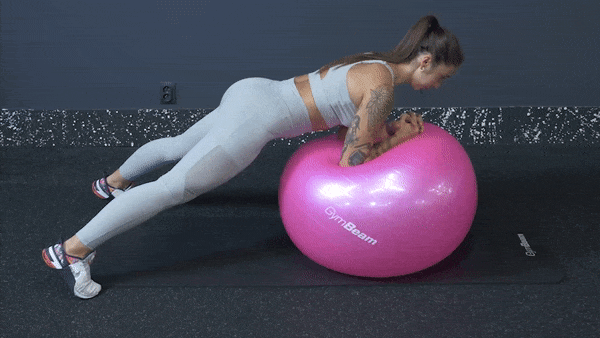
Easier Variation: Knee Plank Roll-Outs
You can simplify this exercise as well. Just adjust the starting position by kneeling. Then, proceed in the same way as in the version with extended legs.
4. Side Plank
- Starting Position: Stand sideways next to the ball and do a forearm plank on it with one arm. You can place your other hand on your hip. Keep your legs extended, leaning on the insteps, with the upper leg a step forward compared to the lower one. Tighten your body and try to keep it in a straight line.
- Execution: Breathe naturally, keep your body tightened, and try to hold this position for at least 15 seconds. Then, switch sides. You can make the exercise more intense by raising your other arm toward the ceiling.
- Common Mistakes: Arching your back, excessively lifting your pelvis upwards, dropping your hips towards the ground.
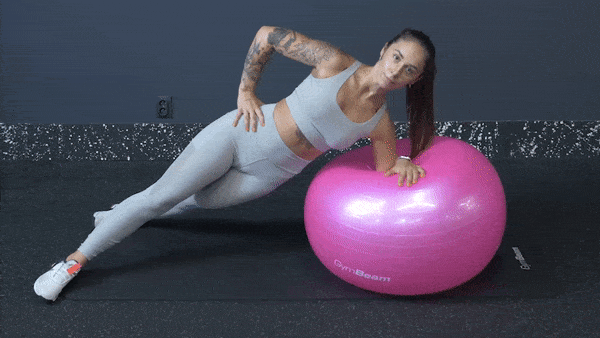
Easier Variation: Knee Side Plank
You can make this exercise easier by kneeling and placing your knees together, providing an additional point of support.
Discover our bestsellers:
5. Twist
- Starting Position: Lie on your back on the exercise ball, bend your knees, and keep your feet on the ground. Extend your arms forward and clasp your hands together. Activate your core.
- Execution: Exhale as you rotate all the way to one side. Inhale as you return to the starting position, and repeat the movement on the other side.
- Common Mistakes: Inadequate range of motion, uncontrolled movement.
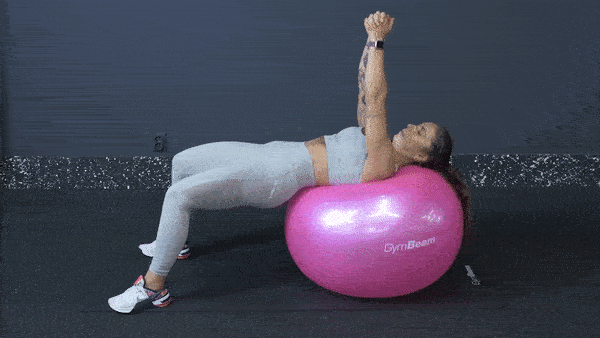
Harder Variation: Weighted Twist
You can make the exercise harder by adding weight to your hands, such as using a small dumbbell or wrist weights.
6. Scapula Pulldown
- Starting Position: Lie on the ball with your upper thighs, pelvis, and abdomen. Anchor your feet into the ground with your toes pointed, keeping them extended and about a meter apart. Extend your arms, pull your shoulders away from your ears, and keep your head in line with your spine. Activate the muscles in your core, back, and buttocks.
- Execution: Exhale as you draw your elbows toward your sides. Hold the bottom position for 1–2 seconds, then inhale as you return to the starting position. Immediately proceed with the next repetition.
- Common Mistakes: Excessively arching your back, raising your shoulders, uncontrolled movement.
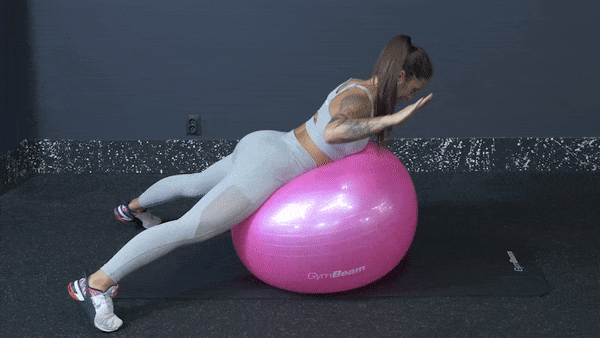
Harder Variation: Resistance Band Scapula Pulldown
Grab a resistance band or expander with both hands and pull it either in front or behind your head.
7. Knee Tuck and Push-Up
- Starting Position: Assume a plank position with extended arms, placing your shins and knees on the exercise ball. Position your hands to be approximately under your shoulders. Extend your legs, tighten your body, and try to keep it in a straight line.
- Execution: In the first phase of the exercise, exhale as you pull your knees towards your elbows, and inhale as you return to the starting position. Immediately proceed to the second phase, where you bend your arms at the elbows and perform a push-up. Continue alternating between knee tucks and push-ups.
- Common Mistakes: Arching your back in the starting position, limited range of motion, uncontrolled movement.
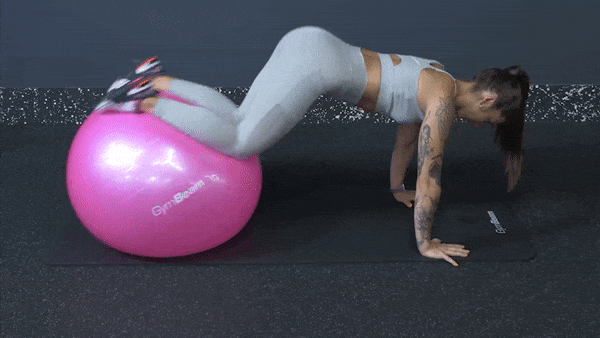
Easier or harder variation of the exercise
You can make the exercise easier by moving the ball closer to your hands. To make it more challenging, try performing the pike instead of knee tucks.
8. Hamstring Curl
- Starting Position: Lie on your back, extend your legs, and place your heels on the top of the exercise ball. Position your arms alongside your body with palms facing down.
- Execution: Activate your gluteal muscles to lift your pelvis. Keep your head, upper back, and arms on the mat, serving as support points. Move the exercise ball towards you by bending your knees and rolling it from heels to toes. Then, return it to the starting position by extending your knees and shifting from toes back to heels. During the rolling motion, you should feel the engagement of the hamstring muscles. The core is also actively involved. Keep your pelvis elevated throughout the exercise.
- Common Mistakes: Excessively arching your back, insufficiently engaging your glutes, thighs, or abdominal muscles, inadequate range of motion.
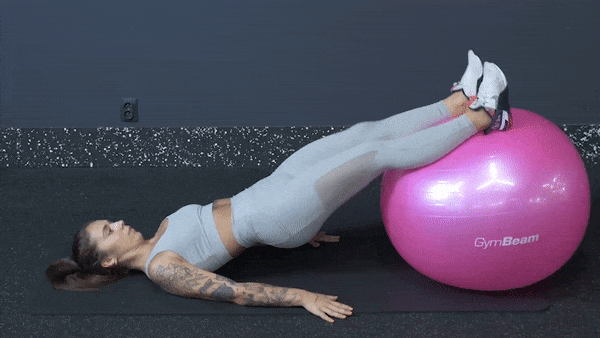
Harder Variation: Hamstring Curl with Glute Bridge
You can make the exercise harder by incorporating a glute bridge. During the phase where your knees are bent, lower your buttocks to the ground, lightly touch the mat, and then lift your pelvis upward. Subsequently, perform one repetition of the hamstring curl and continue alternating between these two exercises.
Exercise Ball Exercises to Strengthen Your Core
For more workout ideas using an exercise ball, feel free to watch our video.
Where to go from here?
- If you want to strengthen your abdominal muscles and tone your stomach, check out the article: 13 Best Exercise Ball Exercises for Strong Abs
- You can create an effective ab and glute workout based on the article: 10 Effective Core & Booty Exercises With Fit Ball
- When working through major muscle groups, you can incorporate exercises from the article: Top 13 Exercise Ball Exercises for a Full-Body Workout
- You can also achieve a full-body workout with a balance half-ball. Effective exercises can be found in the article: 10 Best Balance Half-Ball Exercises to Improve Balance, Strengthen Your Back and Entire Body
- If you prefer to exercise more frequently at home, tips on how to get started can be found in the article: How to Start Exercising at Home and Stick With It? Simple Tips to Help You
What are the main takeaways?
Incorporating exercises with an exercise ball can be a great way to spice up your workout routine, prevent stagnation, and achieve better results. They can comprehensively strengthen your entire body while also addressing balance and coordination. Their versatility caters to both beginners and advanced individuals, making them a great fit for everyone’s training plan. However, remember that the best results come with consistent training, at least twice a week. Last but not least, don’t forget to prioritize sufficient rest and a nutritious diet.
If you found this article helpful, consider sharing it with your friends and spreading the inspiration for a workout with an exercise ball.
[1] Larsen, E. 4 Proven Benefits of Stability Ball Exercises: Science And Facts. – https://www.hometraininghero.com/benefits-stability-ball-exercises-science-behind-effectiveness/
[2] Yu, W., Cha, S., & Seo, S. The effect of ball exercise on the balance ability of young adults.– https://doi.org/10.1589/jpts.29.2087
[3] Srivastav, P., Nayak, N., Nair, S., Sherpa, L. B., & Dsouza, D. Swiss Ball Versus Mat Exercises For Core Activation of Transverse Abdominis in Recreational Athletes. – https://doi.org/10.7860/JCDR/2016/23102.8972

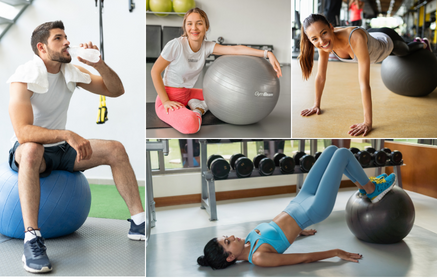
Add a comment